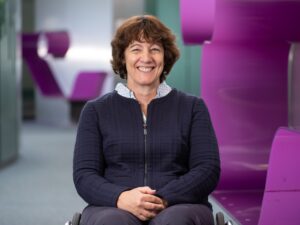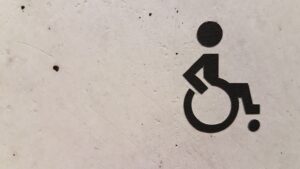
Stephen Cluskey, Co-Founder at Mobility Mojo
John Kersey talks to Stephen Cluskey Co-Founder of Dublin-based Mobility Mojo on making the workplace more accessible.
Mobility Mojo was co-founded by Stephen Cluskey (pictured) and Noelle Daly. At its heart is an assessment tool that provides an on-premise report that feeds an accessibility score for those managing buildings as well as information that is useful for visitors and other users.
The type of buildings covered include offices, hotels and retail premises and the firms already has an impressive portfolio of global clients including hotel chains such as the Dalata, Virgin and Radisson as well as facilities management companies, CBRE, ISS and Sodexo.
Can you tell us something about yourself? What inspired you to get into accessibility?
I have lived my life in two halves – one as a fully able-bodied individual, and the other as a wheelchair user. Coming from a fully active life, and being thrown into the world of disability in an instant, my eyes were opened to a whole new world, full of friction and mostly unnecessary barriers. Having come through many years of rehabilitation and recovery, and the people I met along the way, I discovered how accessibility impacts almost every individual on this planet, and how far behind the world is in catering for that. I began as a passionate advocate, lobbying governments et cetera, but always wanted to do something in the business world. Being able to combine impact with business has been a game changer.
How did Mobility Mojo come into existence?
Noelle, our co-founder, and myself, were actually pitching against each other at a social entrepreneurs event in Dublin. She had a solution around accessible accommodation, I had a solution around accessible transport, and when we both didn’t make it through to the next round of the competition, we decided to join forces to try to have some impact in the world. Mobility Mojo was born, and has evolved over time into what you see today. We genuinely believe what we are doing will change the world.

Noelle Daly, co-founder of Mobility Mojo
What was your vision for Mobility Mojo?
When we started out, the problem we were looking to solve was of the 1.2 billion people globally with disabilities (about 15% of any population), more than half that group were not travelling because of a lack of information on accessibility. We initially developed a trip advisor type platform for people with disabilities but learned through a lot of hard work and time that it didn’t solve the problem. Our philosophy changed significantly in realising that accessibility should be part of the mainstream, not something segregated just for people with disabilities. Version 2.0 was effectively born after that by integrating accessibility information directly on hotel websites, and it continues to deliver impact to this day. Post Covid our vision changed and the big problem we are now looking to solve is supporting workplaces with measuring and improving their accessibility, to help reduce the 60% unemployment rate of people with disabilities.
How does Mobility Mojo operate? Are you a purely remote working enterprise?
Our technology enables a building manager to evaluate their building in the space of 1-3 hours on average. We receive that information into our system and our accessibility experts look through it for accuracy. On the back of that, we provide each building with a detailed accessibility report (based on best global accessibility standards), highlighting improvements broken down by cap-ex light and cap-ex intensive. We work with some of the leading global companies across their entire portfolio of buildings, enabling them to measure their accessibility levels across the world. We also have an employee facing element, which can be integrated into employee apps and intranets, so that employees have full visibility on the accessibility of each of the workplace buildings.
Mobility Mojo has an impressive list of major global companies working at scale? Have you noticed specific benefits that they have received through use of the service?
We’re incredibly fortunate to be working with so many of the largest companies in the world and thankfully they all seem as passionate as we are about improving diversity and inclusion, and in particular accessibility levels, across their workplaces. Through our journey working with them, they seem to have gotten the following benefits:
- Detailed understanding of the accessibility levels of their workplaces;
- Tangible accessibility measurement as a baseline to improve upon;
- Quick win, cost inexpensive things they can do to improve their accessibility;
- Larger improvements to be able to plan and include with future renovations;
- Measurement targets around diversity and inclusion;
- Measuring their workplaces by best global accessibility standards;
- Full accessibility insights for global leadership teams;
- Employee experience improvement.

Credit: marianne bos/Unsplash
From your experience both as an accessibility expert but also as a person with disabilities, what could organisations be doing to improve accessibility?
The first thing is to be conscious of it, which not every organisation is. Do you know how accessible or inaccessible your building is? It’s okay to have the most inaccessible buildings in the world, we get that. It’s not okay to expect others to be fully aware of that. Think of buildings throughout historical cities like Rome and Athens. In many cases, not much can be done to improve. But the big takeaway is to let people know. If you think of someone like myself, as a wheelchair user. Imagine I turned up at a building thinking I would be able to get in, and cannot when I arrived. Who wins in that situation. The building manager is embarrassed, I’ve taken an unnecessary journey, and there is frustration on both sides. Let people know, it’s a huge help.
Do you see different attitudes towards accessibility within different countries and organisations around the world?
We’ve primarily been working with global organisations who have standards which they tend to implement across the world. Through our work, they’ve been able to implement a consistent accessibility standard. We have worked with buildings in the US, Europe, and less developed countries in terms of accessibility like South Korea, Saudi Arabia, Jordan, Colombia, and many more, and while their accessibility scores varied, they all wanted to be part of this improvement journey. It was incredibly reassuring to see such a consistent attitude towards this.
There is a view that accessibility is more than the traditional agenda of wheelchairs and ramps, are you looking at other aspects such as neurodiversity?
Absolutely. And just to be clear – when we talk about accessibility, we are actually talking about almost every individual on this planet at some stage in their lives. Think of your mother or father with a bad hip or knee, yourself with glasses and maybe forgetting them, and the 1.2 billion people globally with visual, hearing, mobility, neurodiverse and beyond challenges. We want to impact every individual on this planet.
A groundswell appears to be building for a more inclusive society, how do you see this impacting accessibility in the future?
We’ve been incredibly fortunate to work with so many amazing clients, and they are all intent on progressing the diversity and inclusion agenda, to create a more inclusive society. Accessibility is a big part of that. A community cannot be inclusive if it is not accessible. Accessibility needs to be built into every part of the diversity and inclusion journey. And thankfully – that’s beginning to happen.
Why should you subscribe to the SHP newsletter?
Do you want the very latest health and safety news, product launches, job listings and expert opinions sent straight to your inbox daily?
The SHP newsletter is essential reading – sign up today to get your hands on all this!





Mmmm, what’s happening following UK Gov 2018 Accessibility Reg’s for the 43,000 (10%) of Dyslexic civil servants or Neurodiverse within the 58% of DSE user operators suffering debilitating eye-strain, binocular vision stress, blurred or worse double vision, migraine, CVS, vision loss due to myopic and asthenopic disease !?
Have they produced their Accessibility Maturity Reports over the last two years following Sept 2020 deadline for implementing Accessibility Statements !?
Or is the HSE Better Display Screen RR 561 2007 still being expediently ignored let alone 2016 WHO ICD-10 !?
https://www.hse.gov.uk/research/rrpdf/rr561.pdf
https://icd.who.int/browse10/2016/en#/H53.1
https://www.youtube.com/watch?v=2C1jmwGIsGQ&list=PLezLOQBs0kcn1kCE3A_Jr5eShBiLu3kKy&index=4&t=125s